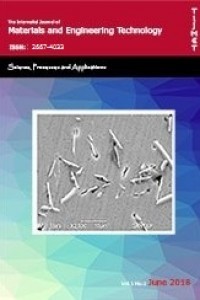NUMERICAL ANALYSIS OF CHLORIDE ION PENETRATION IN SEMI-INFINITE SOLID EXPOSED TO A SALINE ENVIRONMENT: THE 1-D CASE
NUMERICAL ANALYSIS OF CHLORIDE ION PENETRATION IN SEMI-INFINITE SOLID EXPOSED TO A SALINE ENVIRONMENT: THE 1-D CASE
Finite element semi-infinite, concrete,
___
- [1] Poulsen E. (1995), Chloride Profiles. Analysis and Interpretation of Observations. AEC Laboratory, 20 Staktoften. DK-2850 Vedbaek, Denmark. epas 1995-12-01[2] Kropp, J. (1983) Karbonatisierung und Transportvorgänge in Zementstein. Dissertation Universität Karlsruhe.[3] Lizarazo-Marriaga J. and Claisse P. (1995), Determination of the concrete chloride diffusion coefficient based on an electrochemical test and an optimization model. Supported of the Universidad Nacional de Colombia, Colfuturo, and the programme al an (the European union programme of high level scholarships for Latin America, scholarship no. E06d101124co)[4] Roa-rodriguez G., Aperador W., Delgado A. (2013), Calculation of chloride penetration profile in concrete structures. Int. J. Electrochem. Sci., 8 (2013) 5022 – 5035[5] Markeset G. and Skjølsvold O. (2009), time dependent chloride diffusion coefficient – field studies of concrete exposed to marine environment in Norway. Supported by coin-concrete innovation centre, one of presently 14 centres for research based innovation in Norway, initiated by the research council of Norway.[6] Merretz W., Smith G. and Borgert J. (2003), Chloride diffusion in concrete specifications a contractual minefield. Paper was prepared for, and presented at the 2003 biennial conference of the concrete institute of Australia[7] Metselaar R. (1984), Diffusion in Solids. Part one: introduction to the theory of diffusion. Eindhoven University of technology. Emmse coordinator, materials research laboratory, the Pennsylvania state University, University park, pa 16802[8] Reddy J. N. (1993), An introduction to the finite element method, mcgraw-hill, second edition, Texas, (1993).[9] Costa A. and Appleton J. (1999), Chloride penetration into concrete in marine environment – Part l: Main parameters affecting chloride penetration. Materials and structures/Materiaux et Constructions, vol. 32, pp 252 – 259.[10]Costa A. and Appleton J. (1999), Chloride penetration into concrete in marine environment – Part ll: Main parameters affecting chloride penetration. Materials and structures/Materiaux et Constructions, vol. 32, pp 354 - 359[11]Illston J.M., Dinwoodie J.M. and Smith A.A. (1972), Concrete, Timber and Metals, the nature and behaviour of structural materials. Van Nostrand Reinhold Company Ltd, A Division of Litton Education Publishing inc. 135 West 50th street, New York.[12]Sergi G., Yu S.W. and Page C.L. (1992), Diffusion of chloride and hydroxyl ions in cementitious materials exposed to a saline environment. Magazine of Concrete Research, 1992, 44, No. 158., 63-69.
- Yayın Aralığı: Yılda 2 Sayı
- Başlangıç: 2018
- Yayıncı: Necip Fazıl YILMAZ
ANN IN ESTIMATION SHEAR MODULUS OF LAMINATE COMPOSITE
Halil İbrahim KURT, Necip Fazıl YILMAZ, Murat ODUNCUOĞLU
PARAMETER ESTIMATION FOR LINEAR REGRESSION USING BOOTSTRAP METHOD
TENSILE MODULUS OF LAMINATE COMPOSITES
Halil İbrahim KURT, Necip Fazıl YILMAZ, Murat ODUNCUOĞLU
Erhuvwuvoke EBOJOH, John Ajokpaoghene AKPOBİ
INCREASING OF ENERGY EFFICIENCY FOR INTEGRATING SMALL SCALE PV POWER GENERATION TO GRID
